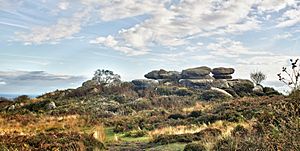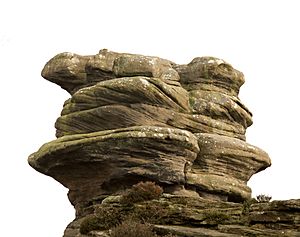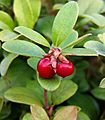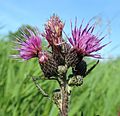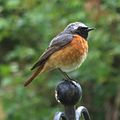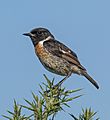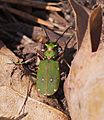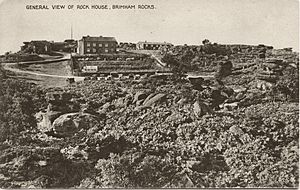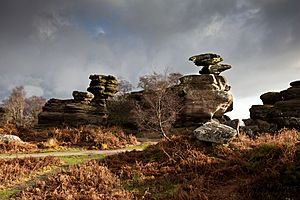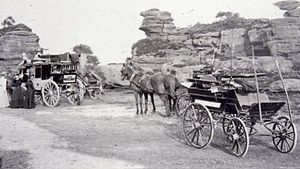Brimham Rocks facts for kids
| Site of Special Scientific Interest | |
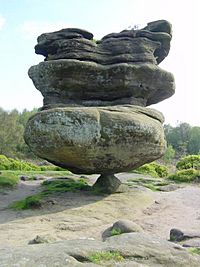
Idol stone at Brimham Rocks
|
|
| Area of Search | North Yorkshire, England |
|---|---|
| Coordinates | 54°04′51″N 01°41′08″W / 54.08083°N 1.68556°W |
| Interest | Biological, geological |
| Area | 183.8959 hectares (1.839 km2; 0.7100 sq mi) |
| Notification | 19 February 1988 |
| Location map | Defra Magicmap |
Brimham Rocks is a huge area of amazing rock formations in North Yorkshire, England. It covers about 184 hectares (454 acres). This special place is part of the Nidderdale Area of Outstanding Natural Beauty. It's also a Site of Special Scientific Interest (SSSI). This means it's protected because of its important biological and geological features.
The rocks here were formed over 325 million years ago. Wind and water have slowly carved them into fantastic shapes. Some look like animals, and others look like strange objects. For a long time, people wondered if ancient druids had carved some of them. This idea led to names like Druid's Idol and Druid's Altar.
Brimham Rocks is special because of its unique geology. It also has different types of heathland and woodlands. These habitats are home to rare and special plants. Examples include chickweed wintergreen and bog asphodel.
Contents
What makes Brimham Rocks special?
Brimham Rocks is a large area of land in North Yorkshire. It's about 184 hectares (454 acres) in size. This site is protected as a Site of Special Scientific Interest (SSSI). It's also a Geological Conservation Review (GCR) site. This means it's recognized for its important rocks and landforms.
The National Trust looks after Brimham Rocks. They have a visitor centre, car park, and paths for people to explore. The site was first protected in 1958. It's special because of its unique geology. It also has important heath and bog habitats. These areas are home to many plants and animals. They used to be more common but are now rare.
The site includes different types of land. There are birch woodlands and acidic bogs. You can also find both wet and dry heathland. Many plant communities grow here. Some are sheltered by the rocks, while others are out on the open moor.
How were the rocks formed?
The rocks at Brimham are made of a type of sandstone. It's called Lower Brimham Grit or Lower Plompton Grit. This rock was laid down about 318 to 317 million years ago. It happened during the Carboniferous period. The sand came from ancient rivers. These rivers flowed into a delta environment. This means the sand was deposited in layers. You can see these layers as cross-bedding in the rocks.
Scientists say Brimham Rocks is a "classic geomorphological site." This means it's great for studying how weather changes land. The amazing shapes you see today took a long time to form. Much of it happened over the last 100,000 years. This was during and after the last ice age.
Wind and ice have also helped shape the rocks. They wore away softer layers. This created holes and strange shapes. The famous Idol rock, for example, is slowly changing. It won't look the same forever.
Were Druids involved in shaping the rocks?
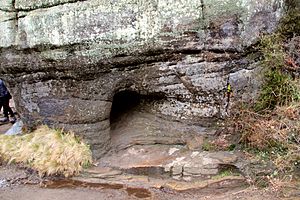
For a long time, people wondered if Druids had carved the rocks. This idea was popular in the 1700s and 1800s. It was a time when people were very interested in ancient Druids. Some writers thought the Druids might have used the rocks for ceremonies. They imagined the Druids using holes in the rocks to give predictions.
However, by the early 1900s, scientists understood the truth. They realized the rocks were shaped by natural forces. Wind, water, and ice did all the work. Even so, some rock names still remind us of these old Druid theories.
What are the rocks called?
Many of the rock names have been used for over a hundred years. Some names were made up to entertain visitors. Others came from the old Druid theories. For example, the Idol Rock and Druid's Writing Desk are famous.
Some names are much older. The Noonstone used to show midday by its shadow. The Great Cannon and Little Cannon (now Smartie Tube) are also old names. Other fun names include Lovers' Leap, Baboon's Head, Pulpit Rock, Frog and Tortoise, Dancing Bear, Sphinx, and Mushroom.
Today, the National Trust has a "Spot the Rocks" trail for children. It lists eleven rock names. Some newer names include Meerkat and Smartie Tube.
What plants and animals live here?
Brimham Rocks is home to many different plants and animals. The land has been used for farming and hunting. Visitors have also walked here for hundreds of years. This has changed some areas. But much of the heathland is still very natural.
Plants of Brimham Rocks
You can find special plants here. On the dry heathland, you'll see cowberry. This plant is mostly found in northern areas. There are also oak, rowan, and silver birch trees. The ground is covered with wavy hair-grass, bilberry, and different types of heather. Bracken grows under the rock stacks.
At the south end of the site, there's wet heath. This area has shallow soil and a small stream. Here you can find wood horsetail and marsh thistle. It also has bog asphodel. You might even spot cranberry in wet spots.
Animals of Brimham Rocks
Three types of deer live on Brimham Moor. These are red deer, roe deer, and sika deer.
Birds
National Trust rangers watch the birds here. Bird boxes have attracted many species. These include tawny owls, treecreepers, and spotted flycatchers. You might also see redstarts, nuthatches, and pied flycatchers. Large birds like red kites, buzzards, and kestrels fly overhead. In summer, house martins and swallows are common. On the heath, look for meadow pipits and red grouse.
Insects
Brimham Rocks is home to special butterflies. These include the Green hairstreak and holly blue. Other insects like the green tiger beetle live here. A type of solitary bee, Colletes succinctus, also thrives among the heather.
How is Brimham Rocks cared for?
The National Trust manages Brimham Rocks. They work hard to protect this special place. They avoid using chemicals like fertilizers and pesticides. These would harm the plants and animals.
Local farmers can graze their animals on some parts of the land. National Trust staff work all year. They maintain paths, record birds, and remove litter. They also control plants like bracken and silver birch.
Caring for the rocks
The rocks need to be kept clear of plants and loose debris. This helps keep their unique geology visible. New buildings or trees should not hide the rocks. Rock climbing is popular here. But it must be balanced with protecting the rock features. Collecting rock samples is not allowed.
Caring for the heath
The plants on the heath need acidic soil. This soil is poor in nutrients. It's partly due to layers of sphagnum moss or peat. This environment supports many animals and insects. Light grazing by animals helps keep trees and shrubs from growing too much. But too much grazing can harm the soil.
Sometimes, heather-burning is used to manage the land. But this is done very carefully. It needs approval from English Nature. Burning can harm plants and nesting birds. It can also cause erosion. Cutting plants is a good alternative to burning. It helps protect the soil.
Caring for the woodland
The woodlands here are special. The clean air and rain make them a home for rare plants and animals. The National Trust protects these woods. They make sure animals don't overgraze them. This helps plants and animals grow.
Sometimes, parts of the woodland are coppiced. This means cutting trees to let in more light. Trees are also allowed to grow and die naturally. Harmful plants like rhododendron are removed. The mix of plants where the woodland meets the heath is also protected.
History of Brimham Rocks
People have lived in this area for a very long time. In 1786, an expert named Hayman Rooke found ancient burial mounds (called barrows) here. He also found what he thought was a stone circle. However, these findings have not been seen since.
The name "Brimham" comes from an old word. It means "tree in clearing." This was recorded in the Domesday Book in 1086. For centuries, the land was used for pasture. In the 1700s, it became a popular place for fox-hunting.
In the 1840s, some people caused damage. They burned off the moss and set fires on the moor. This was during a severe drought.
History of Rocks House
Rocks House was built in 1792. It was a hunting lodge. It also provided a place for visitors to stay. It's now called Brimham House or the Visitor Centre. For many years, it was home to the caretakers of Brimham Rocks. It also had a souvenir shop and a tea house.
In the 1970s, the National Trust restored the building. Today, it has a shop and information centre. It also has solar panels.
People who looked after the rocks
Many people have worked at Brimham Rocks over the years. They helped visitors and looked after the site.
John Spooner (died 1819) was one of the first guides. He was known for showing visitors around for over 30 years.
Richard and Hannah Weatherhead ran Rocks House in the 1830s. They offered teas and refreshments. Richard would even recite poems during tours.
William Brown became the tenant in 1882. He used Rocks House for visitors. He also farmed nearby. Sadly, he died in 1914 in an accident. He was riding on a motor bus when he hit an overhanging rock.
Fred and Mary Ann Burn took over in the 1920s. They grew produce and served food in an old army hut. They even charged a bishop for a service once!
Heslington William Robinson "Essie" Houseman was the next tenant in 1938. The house fell into disrepair during his time. The tea house was destroyed by fire in 1948. After that, a caravan was used for teas until 1970. That's when the National Trust took over.
Visitors to Brimham Rocks
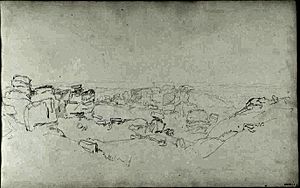
Brimham Rocks became a tourist spot in the late 1700s. People admired the strange shapes and huge size of the rocks. They found the place beautiful and inspiring.
In the 1800s, people loved to imagine stories about the rocks. They saw them as a "superhuman battlefield." They imagined giants throwing rocks around.
Many groups visited, including the Yorkshire Union of Mechanics' Institutes. They would have conferences and then visit the rocks. Guides would explain the geology. They also talked about the old Druid theories.
How tourists traveled here
In the 1800s, visitors often came by hired carriages. This was especially true for people visiting the Harrogate spa.
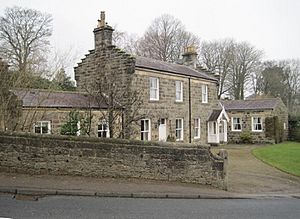
When railways arrived, it became easier to visit. A train station opened at Dacre in 1862. This brought even more tourists. By 1906, there was a motor bus service from Dacre Banks Station.
Today, the National Trust has a car park near the entrance. They also built an accessible path to Brimham House.
Other interesting spots nearby
Adam's Ale spring
This is a natural spring. It's just outside the main Brimham Rocks area. Its name is carved on a stone nearby.
Brimham Beacon
Brimham Beacon is a high point on Brimham Moor. It's just outside the SSSI border. For centuries, signal fires (beacons) have been lit here. In 1887, a huge beacon was lit for Queen Victoria's Jubilee. It sent signals to other beacons far away.
Cup and Ring stone
This is an ancient stone with carvings. It has about 21 circular marks and wavy lines. It's a protected monument.
Noonstone
The Noonstone is a natural rock stack. It's on a high point, surrounded by trees. In the past, it used to cast a shadow on a nearby cottage at noon. Local people used to light fires next to it on Midsummer Eve.
Lost stone circle
An old stone circle was mentioned by Hayman Rooke in 1786. He said it was west of the main rocks. But no one has seen it since. An 1854 map shows a "Druid's Circle." But that spot is now just natural rock stacks.
Images for kids


